Want to know more about ESCRIBA?
Simply register here for our e-mail distribution list.
For more than 20 years, ESCRIBA has been supporting customer projects for the digitalisation of the HR sector. Despite good progress and success, there still seems to be a lot of room for improvement. In order to make our experience measurable, we participated as a partner in the COMPUTERWOCHE study “Digitalisation in HR”. The results provide information about the current digitisation status in HR and what companies are planning for the future.
In the following article, we present the key findings of the study and provide you with assessments and recommendations for action.
In the multi-client study “Digitalisation in HR” conducted by Foundry (formerly IDG), top (IT) managers of companies in the DACH region were interviewed in an online survey. In the period from 15 to 20 April 2021, a total of 355 completed and qualified interviews took place with strategic decision-makers in the C-level area and the specialist departments, specialists from the IT area and senior HR employees. In addition to ESCRIBA, the study partners were Blue Reply and UKG.
Get the whole study with all results, figures and analyses here.
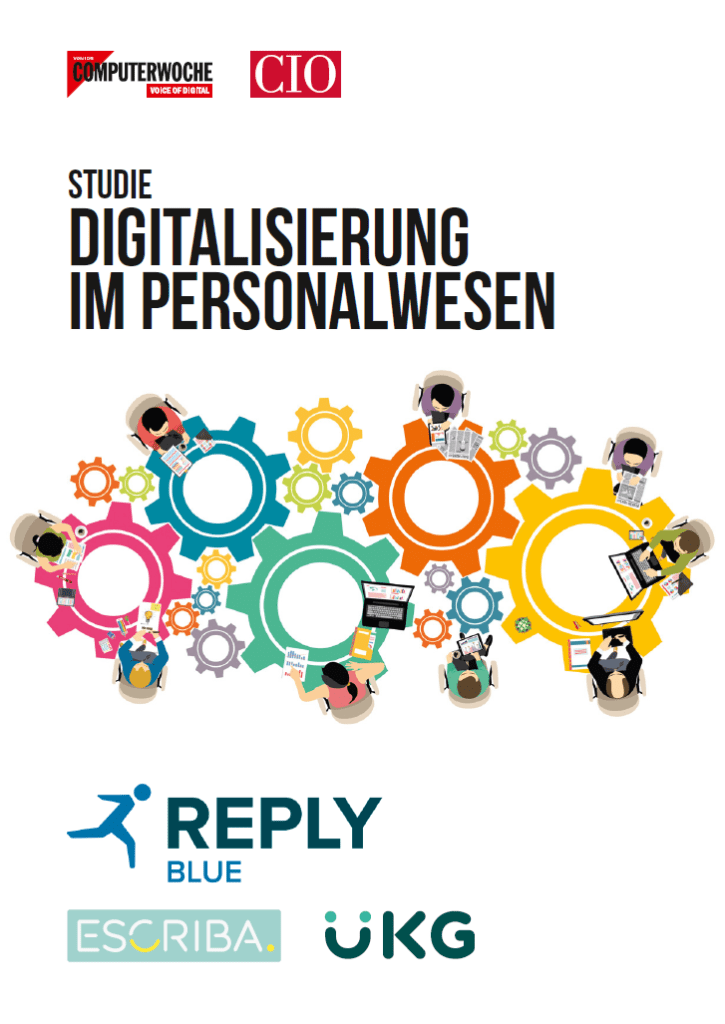

First of all, our gut feeling is confirmed with facts. The survey revealed that no one believes that HR is already fully digitalised. This is not surprising, because at the same time, more than 90 percent consider Excel to be important for their daily work. For the professional side, Excel is without question a pragmatic solution, because HR professionals have it in their own hands and can keep their processes running independently of IT. However, Excel also has its limits, making processes not only inefficient and inconvenient, but also a risk factor. For example, Excel is not a task manager with which tasks can be dynamically planned and monitored, not to mention automatic reminder functions or predefined approval processes. Likewise, documents cannot be created, filed or sent in Excel. And access authorisations, protection against overwriting, deletion, avoidance of redundancies, etc. can only be insufficiently mapped with it.
A detailed analysis of the risks with regard to the GDPR would go beyond the scope here, but let’s briefly look at one exemplary aspect: According to the Data Protection Act, every company must be able to provide information about the storage and use of personal data at any time and to delete it upon request. An analysis at one of our clients showed that an incoming Excel file exists on average 70 times in the company after four weeks. In most cases, no one knows which file is the original and which is the most recent version, who edited it, when and how, and where it was saved. The existence of data from only one person increases so quickly that the effort for information or deletion becomes immeasurable after a short time and in the end all data is still not found without doubt.
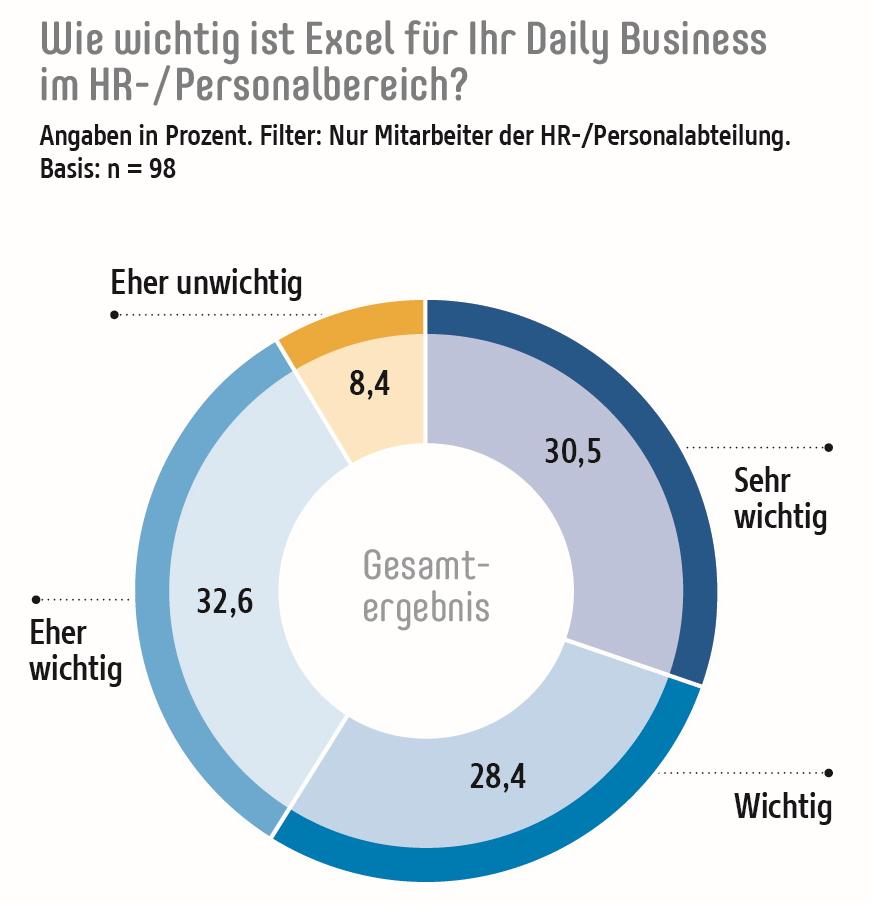
A look at the survey shows how wide the range of topics and processes in HR is. In the adjacent chart, you can see not only the portfolio of HR, but also that the degree of automation of the processes, apart from payroll accounting, is in the lower half. We know from our experience that there are many manual service processes here, which are often also associated with the creation of documents.
It is therefore understandable that the demand for software solutions with data interfaces, integrated workflow and document management as well as automatic evaluations is growing. But often the IT department does not go along with this. Firstly, they have already invested a lot in the digitalisation of HR and insist on the systems that are already in place. These are verifiably well positioned in the core tasks, such as payroll accounting, time recording, digital personnel files and applicant management. If the planned roll-out of these tools is included, software use in these four areas ranges from 86 to over 90 percent.
Zweitens kann die IT – und das auch zurecht – nicht für jedes Einzelthema eine Anwendung einkaufen oder gar selbst entwickeln. Hier stehen bei den ohnehin begrenzten Kapazitäten Aufwand und Nutzen nicht im Verhältnis. Und, was noch deutlich riskanter wäre, es würde ein IT-Wildwuchs entstehen, der einem Anwendungs-Zoo gleicht. Die IT ist gut beraten, nach dem 80/20 Prinzip zu arbeiten: etwa 80 Prozent der Prozesse sind mit einem oder wenigen Systemen digitalisiert. Für die restlichen 20 Prozent ist der Aufwand so groß, dass es schlichtweg zu teuer und zeitaufwändig ist.
Secondly, IT cannot – and rightly so – acquire an application for every single topic or even develop one itself. In view of the already limited capacities, the costs and benefits are not in proportion. In addition, an IT jungle could grow, which would be even more risky. IT is well advised to work according to the 80/20 approach: about 80 per cent of the processes are digitised with one or a few systems. For the remaining 20 per cent, the effort is so high that it is simply too expensive and time-consuming.
In summary, the picture is familiar to many companies: the core HR systems are running and IT is responsible for them. In addition, there are still many micro and sub-processes that are digitised as best they can by the HR staff themselves – Excel is the tool of choice here. The processes remain inconvenient and inefficient, risks are still present and IT has neither capacities for new applications nor does it want to find HR self-runners and shadow IT.
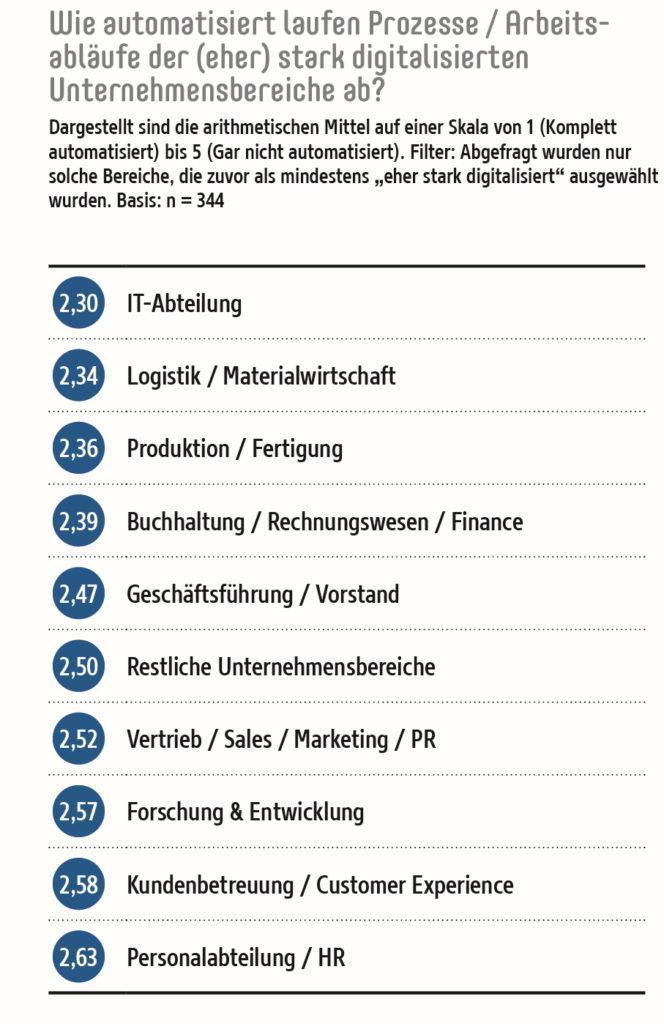

As complex as the challenge sounds, the solution can be simple. In recent years, no- and low-coding has become a technology that delivers enormous value precisely in this area of tension. After a brief explanation of the terms, you can read why no-/low-coding solves seven challenges at once.
Even though it is often mentioned in the same breath, one must fundamentally separate no-coding from low-coding. No-coding means, as the name suggests, that no programming code has to be written for the development of a software application. It is created using a graphical user interface or automatically when functions are selected and combined. This means that no-coding is primarily aimed at non-IT people. Low-coding, on the other hand, is an instrument for IT experts because it requires programming knowledge. The strength of low-coding lies in the fact that a large number of pre-configured and quality-checked code fragments can be used to create software much more quickly and to a higher standard.
However, the real potential of this new paradigm in software development only comes to play when no- and low-coding are linked. The radiance of a no-/low-code platform clearly goes beyond fast and inexpensive software, and this brings us to the seven at one stroke:
1. Minimise (Excel-)risks and ensure compliance
The data is held centrally in the no-/low-code application and you can control and track access and modification in a targeted manner via a rights and roles concept. Thanks to versioning, you have access to the original, the latest variant and all intermediate updates at all times without creating redundancies. Risks due to accidental overwriting, deletion or sending to unauthorised persons are also eliminated.
2. IT sovereignty without uncontrolled growth and shadow IT
With a no-/low-code platform, you can build many individual apps, but IT benefits from the fact that everything runs on a central application. This means that the IT application owner is only responsible for the operation of the platform and its availability. Thus, it also requires only a one-time consideration and integration in software architecture, set-up of the technical infrastructure, authorisation concept, deployment processes, backup scenarios, etc. It is important that IT retain sovereignty and governance over the platform, while the departments themselves are able to act within the defined framework. The standardised technology basis also makes it possible for applications not to remain in the specialist department, but to be made available to other departments or even the entire company, or for individual apps to be linked to form an entire application landscape. This also significantly reduces the risk of shadow IT.
3. Fast and affordable digital solutions (almost) without bottleneck resource IT
Once the no-/low-code platform is anchored in the company, all employees can now build apps on this basis. From a small database that can be created in a few minutes with the “Excel to App” function to more complex solutions with automated workflows, reminders and approval processes, basically anything is possible here. What makes the no-code/low-code approach particularly strong is its flexibility. Users can start with small, very specific solutions to problems and then continuously expand, adapt or even switch off their apps. This relieves the IT in two ways, firstly because experts themselves digitise their processes via no-coding and secondly because low-coding means that they can create even complex applications very quickly in an enormously high quality. If you go about it the right way, this is a liberation from the carousel of capacity bottlenecks.
4. Partnership instead of tension between HR and IT
The fragile or even broken bridge between the business and IT departments can be rebuilt or strengthened with no-code and low-code. Where previously incomprehension and fronts clashed, the no-/low-code platform now forms a common foundation on which both sides work and consequently also begin to speak the same language. This makes it possible for HR staff to start with an idea and later take on colleagues from IT to realise processes that are even more complex or system connections by means of low-coding. This creates an exchange at equal level, which inevitably leads to higher productivity.
Admittedly, a certain basic affinity for technology and thinking in data models is an advantage. Thus, the introduction of no-/low-code technology naturally also means a rethink for HR. Nevertheless, the prerequisites are very good. Firstly, according to the study, HR staff receive good marks for their IT competence. Secondly, 88 percent of HR employees agree that their own further training in IT topics is essential in order to be able to advance digitalisation successfully.
Companies can build on this commitment to learn and teach the basic knowledge for no- and low-code. In this way, HR employees can move from being pure users of software to becoming product owners of their own apps. Once an employee has built his or her first app, a new dynamic quickly emerges that is not known from large-scale projects centrally located in the IT department. Cross-departmental and cross-hierarchical collaboration suddenly becomes a matter of course. No-code/low-code thus paves the way for New Work in a very natural way.
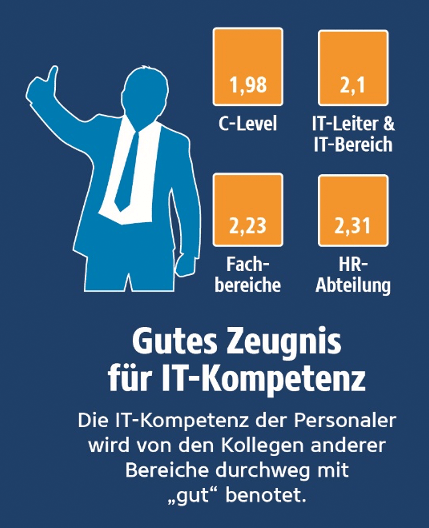
New Work describes that one’s own work is experienced as a way of self-realisation. This includes alternative working models based primarily on flexibility, agility and participation. All these values are supported and promoted when working with a no-/low-code platform. HR often provides impulses for change, but now they are also able to implement it technologically themselves. Self-created software also promotes a high degree of personal responsibility. When developing with no-code and low-code, agile, iterative work often sets in automatically. This gives HR self-determination in digitalisation. With cloud technology, which is also optimised for mobile use, it does not matter at what time or in what place work is done. In addition, the apps provide many useful functions for uncomplicated and effective collaboration between employees or entire teams. In this way, HR not only lives the New Work approach itself, but also takes on the often demanded pioneering role and role model function in the company.
In the study, almost 60 percent favoured a single software solution for digitising HR, whereas more than 30 percent preferred the best-of-breed approach, i.e. putting together the best individual solution in each case. Until now, this question has always been “either – or”, but with no-/low-code there is now a technology that combines both approaches.
Through the simple connection of services and components, special functions such as digital signatures can be easily integrated into the platform. The provider does not have to develop all features himself, but can always connect the best technology available on the market and also exchange it if necessary. Nevertheless, all modules and functions are available to the end user on a central platform. Another advantage is that functional enhancements are no longer only available to the area that commissions them, but to the entire user group. As long as the platform is operated within the company, no one has to worry about whether their application will reach the end of its life cycle or if support will expire.
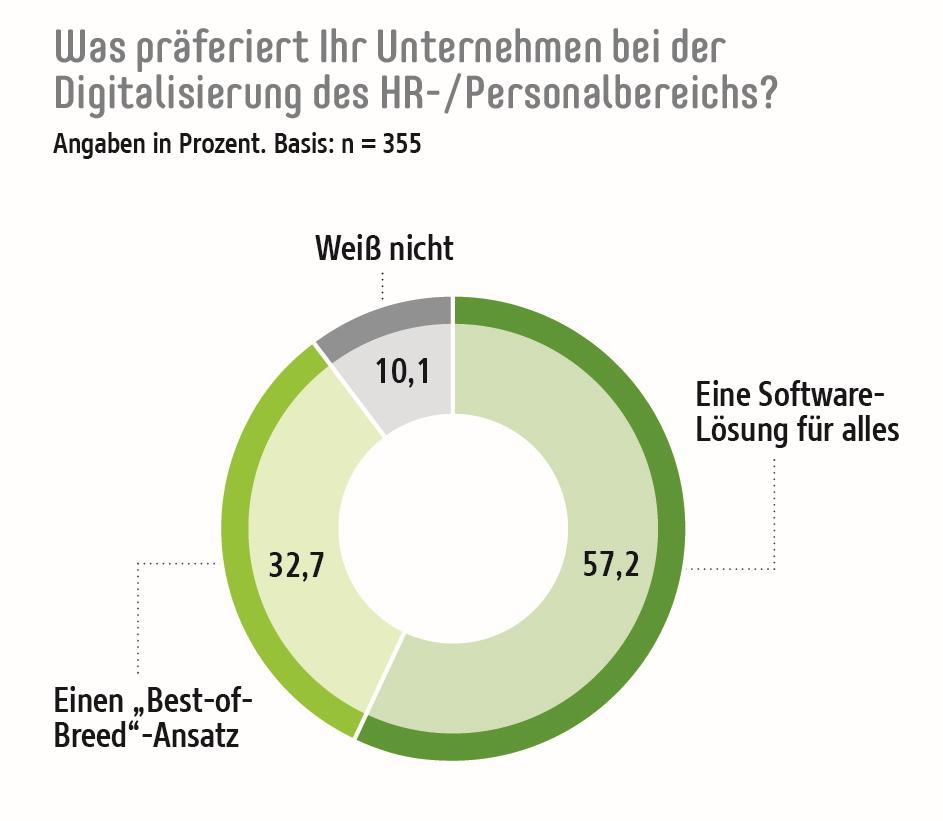
Why ESCRIBA?
ESCRIBA stands for 25 years of living digitalisation in companies. Our heart beats for digital processes and scalable technologies, which we develop on our own no- and low-code platform. With this, we create groundbreaking results in a short time and bring your software world up to speed. Choose from our wide range of pre-packaged solutions or let us develop customised software for your personal use. more >>
Want to know more about ESCRIBA?
Simply register here for our e-mail distribution list.